 |
|
Focus features two in-depth reviews each month of fine art, architecture and design exhibitions and events at art museums, galleries and alternative spaces around Japan. The contributors are non-Japanese art critics living in Japan.
|
|
|
 |
 |
 |
Blacks: In Praise of a Limited Palette
Nicolai Kruger |
 |
 |
|
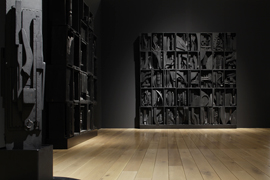 |
| The main entrance of the Kawamura Memorial DIC Museum of Art, in Sakura, Chiba. Photograph by Nicolai Kruger |
|
From left to right, Louise Nevelson's Rain Forest Column VIII (1959), Sky Reflection (1962-77), and Untitled (1964) are stacked wood-box constructions infused with black.
|
There is something to be said for getting out of Tokyo on a sunny weekend just as spring is emerging. About an hour east of downtown and close to Narita Airport, the Kawamura Memorial DIC Museum of Fine Art, located in Sakura City, Chiba, is well worth the trip. The expansive grounds include a lake and a lush nature trail that is free and open to the public. The museum was established in 1990 to display artwork collected by DIC Corporation and its affiliates. Its founder and first director, Katsumi Kawamura, put together the beginnings of an impressive collection that now boasts over 1,000 pieces. Artists who can be categorized as Impressionists, Expressionists, Surrealists, and Avant-Gardists are represented, among them Monet, Picasso, Bonnard, Braque, Kandinsky, and Chagall. The 20th-century contemporary American artists Frank Stella and Mark Rothko each have whole galleries dedicated to them; there are also galleries for traditional and contemporary Japanese works. There is even a precious portrait by the 17th-century Dutch master Rembrandt; the collection really has something for everyone, yet does not feel at all like a hodgepodge of art.
Currently on view is the special exhibition Blacks, featuring three artists for whom the color black has been a distinctive element in their respective careers. The show focuses on the large-scale, three-dimensional wood constructions of Louise Nevelson (1899-1988), the monochrome oil paintings of Ad Reinhardt (1913-67), and the black and white photography of Hiroshi Sugimoto (1948-).
Louise Nevelson was born near Kiev (then part of Czarist Russia) and emigrated to the U.S. state of Maine as a young child. She became one of the country's foremost representative female sculptors and by the 1950s had established her signature style. Usually created out of wood, Nevelson's works appear puzzle-like, with multiple intricately cut pieces set into deep-relief, wall-mounted gshadowboxesh or freestanding sculptures. Inspired by Cubism and Surrealism, she combined raw materials with found objects and incorporated traditional woodworking crafts such as turned wood and spindles. When all of these disparate elements are painted matte black and enveloped in a montage, the result is something entirely new.
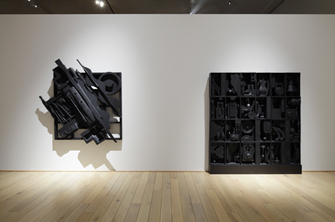 |
|
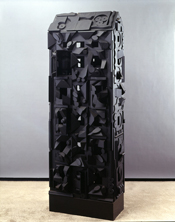 |
| From left to right, Louise Nevelson's Mirror Shadow (1988) and Nocturnal Symphony (1986) are assemblages of what appear at first to be random objects, implemented with strict discipline. |
|
Puzzle pieces fit snugly together to create Dream Home XXX (1972), by Louise Nevelson.
|
A calm silence comes over visitors entering the dimly lit gallery where several of Nevelson's pieces are displayed. It takes some time for one's eyes to adjust to such low contrast. Most pieces, such as Nocturnal Symphony, are tightly contained within a rigid framework. A few, however, seem to break free of their constraints. The diagonally oriented Mirror Shadow is one such work, yet it is still executed according to strict rules Nevelson has set.
Born in Buffalo, New York, Ad Reinhardt rose to prominence as an abstract painter in the postwar era. His earlier work shows a strong Cubist influence and a preference toward geometric forms. By the mid-1950s, he had shifted from painting in red and blue monochrome to exclusively all-black canvases.
The exhibition features Reinhardt's portfolio series 10 Screen Prints plus five large-scale oil paintings that appear at first as jet-black, two-dimensional color fields. The phenomenon of seeing a piece such as Triptych or Abstract Painting No. 34, nearly devoid of variation and contrasted within a bright white exhibition space, feels like staring into a black hole; it is how one might imagine experiencing an inverted James Turrell installation. Upon closer examination, however, the viewer realizes the subtle nuances in shade and tone, and Reinhardt's firm geometric discipline reveals itself.
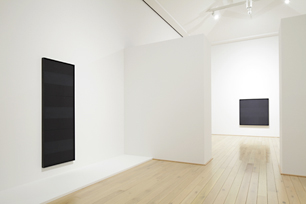 |
|
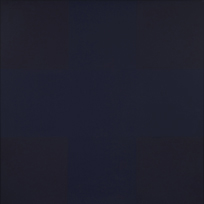 |
| Ad Reinhardt's oil-on-canvas pieces Triptych (1960) and Abstract Painting (1960-66) appear as black holes in the bright white exhibition space. |
|
Upon closer examination, variations in shade and Ad Reinhardt's geometric rigor reveal themselves in Abstract Painting No. 34 (1964).
|
Hiroshi Sugimoto was born in Tokyo. He moved to New York in 1974 to pursue a career in black and white photography but has often crossed over into other genres such as installation and architectural design, and he has collaborated with musicians and performance artists. He cites the Dadaists and Surrealists as major influences and is acclaimed for the conceptual aspects of his work. Sugimoto has a strong interest in the passage of time, as seen in his photographic series; among the most representative are his Dioramas, Seascapes, and Theaters.
On display in Sugimoto's portion of the Blacks exhibition are 28 silver gelatin prints on paper from his Theaters series that span a period of over 20 years (1977 to 1998). Here Sugimoto focused on old-time, mostly American movie palaces. He captured his images by opening the camera shutter and exposing his film for the duration of an entire movie, using the projector as the sole source of lighting. The result is a surreal bright white screen surrounded by subtly lit, rich architectural details but with all of the lush colors -- the gilding and red velvet -- stripped away. As with Nevelson and Reinhardt before him, Sugimoto's rigorous approach reveals that which can only be seen when we see less.
While many artists may have specific periods of monochromic or limited-palette experimentation, Nevelson, Reinhardt, and Sugimoto have each thoroughly and deliberately concentrated on the use of black throughout their careers. Although working in different media and within different contexts, the level of depth that they have achieved in their artistic pursuits is remarkable. Blacks is a sophisticated curatorial effort. The Kawamura Museum has a few pieces by each of the three artists in its permanent collection, but for this exhibition additional pieces were provided on loan. One is from the Leeum, Samsung Museum of Art in Seoul, Korea, but impressively, all the other works come from distinguished institutions or private collections in Japan. Blacks provides a unique opportunity to experience these three prolific artists in juxtaposition.
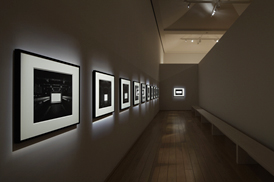 |
|
 |
| A long view of Hiroshi Sugimoto's Theater series focusing on theaters located mostly in the western United States. |
|
A photograph of the Al Ringling Theatre in Baraboo, Wisconsin, taken by Hiroshi Sugimoto in 1995. The theater is one of the oldest in the United States; it opened in 1915 and remains in operation today.
All photographs by Osamu Watanabe, courtesy of the Kawamura Memorial DIC Museum of Art, unless otherwise indicated. |
 |
 |
Nicolai Kruger, AIA
Nicolai Kruger is an architect managing international projects at Pelli Clarke Pelli Architects, Japan. She has been living in Tokyo since 2006. She received her BFA in Design at Cornish College of the Arts in Seattle, followed by her Masters of Architecture at the University of Oregon. Her principal areas of interest include mixed-use, temporary structures, exhibition and lighting design. |
|
 |
|